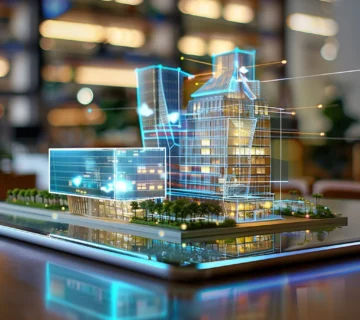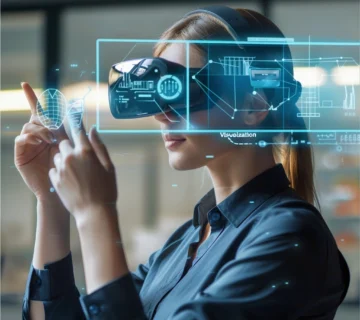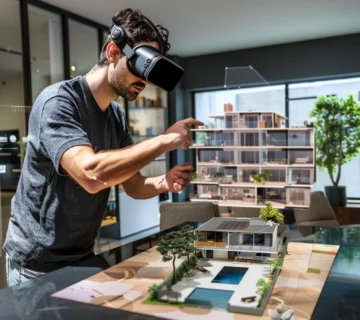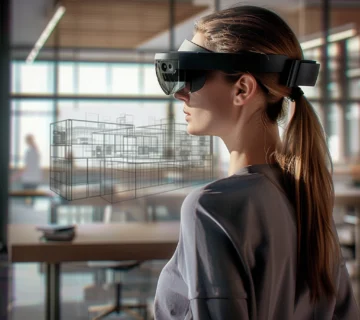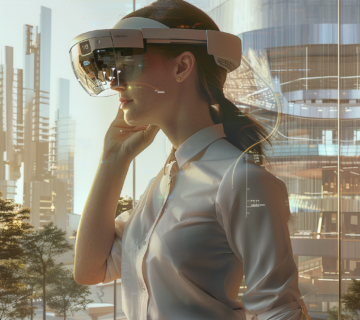Introduction:
In the ever-evolving landscape of technological innovation, AR technology stands as a transformative force, reshaping the way we interact with the digital world. Augmented Reality, often abbreviated as AR, has emerged as a dynamic and immersive technology that seamlessly blends the virtual and physical realms. In this introduction, we embark on a journey to explore the vast potential and applications of AR technology, unraveling its impact on various industries and envisioning the future of immersive experiences.
AR technology, at its core, enhances our perception of reality by overlaying digital elements onto the physical environment. Unlike its counterpart, Virtual Reality (VR), which immerses users entirely in a simulated world, AR technology integrates digital information into our real-world surroundings. This unique characteristic positions AR as a versatile tool with applications spanning education, healthcare, gaming, navigation, and more.
The versatility of AR technology lies in its ability to offer a seamless blend of the digital and physical. Through devices like smartphones, smart glasses, or heads-up displays (HUDs), AR technology integrates into our everyday lives, providing real-time information, interactive experiences, and enhanced visualizations. This accessibility makes AR technology a promising frontier for innovation and user engagement.
As we delve into the exploration of AR technology, it becomes apparent that its impact extends beyond novelty experiences. AR applications have permeated various industries, revolutionizing the way we learn, work, and entertain. The Top 5 AR Applications we are about to unveil represent the pinnacle of AR technology’s capabilities, showcasing its diverse and impactful presence in the modern digital landscape.
AR technology has transformed traditional learning methods:
In the educational realm, AR technology has transformed traditional learning methods by bringing textbooks to life, offering interactive lessons, and providing immersive experiences that captivate students’ attention. In the healthcare sector, AR is revolutionizing medical training, surgical procedures, and patient care, enhancing the capabilities of professionals and improving overall outcomes.
The gaming industry has witnessed a paradigm shift with the integration of AR technology. Augmented reality games, such as Pokémon GO, have captured the imaginations of millions, blurring the lines between the virtual and real worlds. AR technology’s influence on gaming extends beyond entertainment, showcasing its potential to create social and interactive experiences on a global scale.
Navigation and location-based services have experienced a significant enhancement through AR technology. Applications that overlay directional cues, points of interest, and real-time information onto the user’s field of view have simplified navigation and enriched the exploration of new places. This seamless integration of information into the real world marks a pivotal advancement in how we navigate and interact with our surroundings.
Businesses and industries are leveraging AR technology for marketing and customer engagement. Augmented reality advertising campaigns allow consumers to visualize products in their real-world environments before making purchase decisions, providing an interactive and personalized shopping experience. This transformative use of AR technology showcases its potential to reshape traditional business models and enhance customer interactions.
In this exploration of AR technology, it is essential to recognize its role in shaping the future of immersive experiences. The continued evolution of AR applications and their integration into various facets of our lives underscore the transformative potential of AR technology. As we unveil the Top 5 AR Applications, we invite you to delve deeper into the intricate tapestry of possibilities that AR technology brings to the forefront of innovation, promising a future where the boundaries between the digital and physical worlds seamlessly blur, opening new horizons for human interaction and engagement.
Augmented reality definition and application:
In the dynamic landscape of technological innovation, Augmented Reality (AR) stands as a transformative force, seamlessly blending the virtual and physical realms. As we embark on a journey to explore the top applications of AR technology, we unveil a realm of possibilities that not only shape our present but also forecast the future of immersive experiences.”Augmented reality (AR) is the real-time use of information in the form of text, graphics, audio and other virtual enhancements integrated with real-world objects. It is this “real world” element that differentiates AR from virtual reality. AR integrates and adds value to the user’s interaction with the real world, versus a simulation.”[Gartner].
-
Educational Augmentation:
Educational Augmentation through Augmented Reality (AR) has emerged as a transformative force in the realm of education, revolutionizing traditional learning paradigms. By seamlessly integrating digital information and virtual elements into the physical world, AR applications have redefined the educational landscape.One of the most compelling aspects of AR in education is its ability to breathe life into static textbooks. Through AR-enhanced content, students can transcend the limitations of traditional print media, immersing themselves in dynamic visualizations and interactive simulations that elucidate complex concepts. For example, instead of merely reading about the solar system, students can explore it in three dimensions, witnessing the orbits of planets firsthand and gaining a deeper appreciation for astronomical phenomena.Moreover, AR facilitates personalized and experiential learning experiences by overlaying interactive lessons onto physical objects. This approach enables students to engage with educational material in a hands-on manner, fostering a deeper understanding of abstract concepts. For instance, a biology class studying human anatomy can utilize AR to examine virtual 3D models of organs, dissecting them virtually and observing their functions in real-time.
Furthermore, AR-powered immersive learning experiences captivate students’ attention and sustain their engagement throughout the learning process. By transforming traditional lectures into interactive adventures, AR applications turn learning into an exciting journey of exploration and discovery. Whether it’s exploring ancient civilizations through virtual reconstructions or conducting virtual science experiments in a simulated laboratory, AR empowers students to actively participate in their education, igniting their curiosity and fueling their passion for learning.
In conclusion, the educational augmentation facilitated by AR technology transcends conventional teaching methods, offering students unparalleled opportunities for exploration, experimentation, and discovery. By harnessing the power of AR, educators can create dynamic learning environments that inspire curiosity, deepen understanding, and prepare students for success in an increasingly complex and interconnected world.

AR technology is being utilized to educate children. In this scenario, a young girl is seen wearing an AR headset, completely immersed in a new virtual world.

- Healthcare Transformation:
Augmented Reality (AR) is catalyzing a profound transformation in the healthcare sector, revolutionizing various aspects of medical training, surgical procedures, and patient care. By integrating digital information with the physical world, AR applications offer unprecedented capabilities that significantly enhance the effectiveness and efficiency of healthcare practices.One of the most notable impacts of AR in healthcare is its role in assisting medical professionals during surgeries.
AR technology provides surgeons with real-time information overlaid onto their field of view, such as vital signs, patient data, and anatomical structures, allowing for enhanced decision-making and precision during procedures. This augmented visualization not only improves surgical accuracy but also reduces the risk of complications, ultimately leading to better patient outcomes.
Additionally, AR facilitates advanced training opportunities for medical professionals through detailed simulations and interactive learning experiences. Healthcare practitioners can utilize AR to immerse themselves in realistic scenarios, practicing complex procedures and honing their skills in a safe and controlled environment. This hands-on approach to training enhances competency and confidence among medical professionals, ultimately translating into improved quality of care for patients.
Furthermore, AR technology enhances patient care by providing immersive educational experiences and personalized treatment plans. Patients can benefit from AR-enabled medical consultations, where healthcare providers utilize interactive visualizations to explain diagnoses, treatment options, and procedural risks in a more accessible and engaging manner. This fosters better patient understanding and collaboration in decision-making, leading to more informed choices and improved health outcomes.
In summary, the transformative use of AR technology in healthcare is revolutionizing medical practices, from training and surgical procedures to patient care and education. By harnessing the power of augmented reality, healthcare professionals can deliver more precise diagnoses, perform safer surgeries, and provide more personalized and effective treatment options, ultimately leading to enhanced medical outcomes and improved quality of life for patients.

-
Gaming Beyond Boundaries:
Augmented Reality (AR) has not only reshaped but revolutionized the gaming industry, breaking free from the constraints of traditional gameplay and immersing players in a dynamic fusion of virtual and real-world environments. A prime example of this transformative shift is evident in games like Pokémon GO, which captivated millions worldwide and became a cultural phenomenon.
Unlike conventional video games confined to screens, AR games leverage the capabilities of mobile devices to overlay digital content onto the physical world. This innovative approach transforms ordinary streets, parks, and landmarks into vibrant gaming arenas, inviting players to embark on virtual adventures in their neighborhoods.
By blurring the lines between fiction and reality, AR games unlock a new dimension of exploration and interaction, enticing players to venture outdoors and discover hidden treasures in their surroundings.One of the defining features of AR gaming is its ability to foster social interaction and collaboration on a global scale. Players can join forces with friends or compete with rivals in real-time, forging connections and shared experiences irrespective of geographical boundaries.
This social aspect not only enhances the enjoyment of gameplay but also encourages teamwork, communication, and camaraderie among players worldwide.
Moreover, AR gaming promotes physical activity and exploration by incentivizing players to move and explore their environment in search of virtual rewards and challenges. By gamifying exercise and outdoor exploration, AR games motivate players to lead more active lifestyles while having fun simultaneously.
In essence, AR has transcended the conventional confines of gaming by merging virtual entertainment with real-world experiences. Through immersive gameplay, social connectivity, and physical engagement, AR games have set new standards for interactive entertainment, inspiring a generation of players to embark on adventures beyond their imagination.
As technology continues to evolve, the potential for AR gaming to redefine leisure and recreation knows no bounds, promising endless possibilities for immersive and unforgettable gaming experiences.
- Revolutionizing Retail: Augmented Reality (AR) is ushering in a new era for the retail sector by fundamentally transforming how consumers shop and interact with products. With the integration of AR technology, retailers can offer customers a virtual try-on experience that bridges the gap between online and offline shopping. One of the most significant impacts of AR in retail is its ability to provide customers with a realistic preview of products within their physical environments. Through AR applications, shoppers can visualize how clothing, accessories, or furniture will look in their homes or on their bodies before making a purchase. This virtual try-on experience not only enhances the convenience of online shopping but also addresses common concerns such as fit, style, and compatibility.
By leveraging AR, retailers empower consumers to make more informed purchasing decisions. The ability to see products in context helps shoppers assess their suitability and functionality, reducing the likelihood of disappointment upon delivery. This leads to fewer returns and exchanges, thereby streamlining the shopping process for both customers and retailers while minimizing the environmental impact associated with reverse logistics.
Moreover, AR in retail fosters greater engagement and interactivity, enriching the overall shopping experience. Customers can customize and personalize products in real time, exploring different options and configurations to find the perfect match for their needs and preferences. This interactive element not only cultivates a sense of ownership but also encourages repeat visits and brand loyalty.
Furthermore, AR technology opens up new opportunities for retailers to experiment with innovative marketing strategies and immersive storytelling. By creating immersive experiences that blur the lines between virtual and physical spaces, retailers can captivate consumers’ attention and differentiate themselves in a crowded marketplace.
In summary, the integration of Augmented Reality in retail is revolutionizing the way consumers shop and interact with products. By offering a virtual try-on experience, AR enhances the online shopping journey, promotes informed decision-making, and reduces the environmental footprint of retail operations. As AR technology continues to evolve, its potential to reshape the retail landscape and elevate the customer experience remains unparalleled.
-
Architectural Visualization Mastery:
In the realm of architecture and design, Augmented reality design is empowering professionals to revolutionize how they present and conceptualize projects. Augmented reality in architecture applications allows architects to overlay virtual models onto physical spaces, providing clients with a realistic preview of proposed structures.
This interactive Augmented reality in building visualization not only streamlines the design process but also in Augmented reality in construction facilitates better-informed decision-making, contributing to the success of architectural projects.In architecture and design, the utilization of Augmented Reality (AR) design represents a paradigm shift in how professionals conceptualize and present their projects.
Augmented reality in architecture applications enables architects to superimpose virtual models onto real-world environments, offering clients a compelling and immersive preview of proposed structures. This interactive capability allows stakeholders to visualize designs in situ, experiencing the spatial relationships and aesthetics firsthand.
One of the key advantages of AR in architecture lies in its ability to streamline the design process. Architects can efficiently iterate and refine their designs by instantly visualizing how they interact with existing surroundings. This facilitates rapid prototyping and experimentation, leading to more innovative and optimized solutions.
Moreover, Augmented Reality in building visualization enhances decision-making throughout the project lifecycle. Clients and stakeholders can make more informed choices by experiencing the proposed designs in context and considering factors such as scale, proportion, and aesthetics. This leads to greater alignment between project vision and stakeholder expectations, ultimately increasing project success rates.
Furthermore, Augmented Reality in construction offers significant benefits during the building phase. Contractors can use AR to overlay digital blueprints onto construction sites, facilitating accurate spatial planning and minimizing errors. This integration of digital information with physical spaces improves coordination among project teams, enhances on-site efficiency, and reduces construction timelines and costs.
In summary, Augmented Reality transforms the architecture and design industry by providing a powerful toolset for visualization, collaboration, and decision-making. By seamlessly blending virtual and physical realities, AR empowers professionals to create more engaging presentations, optimize design workflows, and deliver superior outcomes for clients. As technology continues to advance, the impact of AR in architecture is expected to deepen, driving innovation and reshaping the way we conceive and construct the built environment.
AR technology Applications:
The unveiling of these Top 5 AR Applications underscores AR technology’s versatile and transformative nature. Its seamless integration into education, healthcare, gaming, retail, and architecture is shaping a future where immersive experiences become an integral part of our daily lives. As technology continues to advance, the trajectory of AR technology promises even more groundbreaking applications, further blurring the boundaries between the virtual and real worlds.
In conclusion, the present and future of immersive experiences are intricately linked to the evolution of AR technology. The unveiling of these top applications showcases not only the current impact of AR but also foreshadows a future where our interactions with the digital realm are seamlessly woven into the fabric of our reality. As we embrace the possibilities presented by AR technology, we usher in an era where immersive experiences become not just a technological novelty but an essential and enriching aspect of our collective existence.
In conclusion, the transformative impact of AR (Augmented Reality) technology is evident across various industries, with five standout applications reshaping our digital landscape.
- Education: AR has revolutionized education by bringing subjects to life through interactive learning modules and virtual laboratories. Students benefit from a dynamic and engaging educational experience, transcending traditional teaching methods.
- Healthcare: AR applications in healthcare offer surgical assistance and realistic training simulations, elevating precision in medical procedures and providing professionals with immersive learning opportunities. The technology continues to enhance patient care and medical training.
- Gaming: Augmented Reality has redefined the gaming industry, exemplified by popular games like Pokémon GO. These experiences bridge the gap between the digital and physical worlds, encouraging physical activity and social interaction on a global scale.
- Retail: The retail sector sees a transformation with AR’s virtual try-ons and shopping assistants. Customers can visualize products in their own spaces, leading to more informed purchasing decisions and an enriched shopping experience.
- Architecture and Design: AR applications empower architects and designers with 3D visualization and interactive presentations. Clients can experience proposed structures in real-world contexts, fostering better-informed decision-making and collaborative planning.
These five applications underscore the versatility of AR technology, influencing how we learn, work, shop, and interact with our surroundings. As the technology continues to evolve, its integration into these key sectors foreshadows a future where augmented reality becomes an integral part of our daily experiences, seamlessly blending the physical and digital realms.
In conclusion, the integration of Augmented Reality (AR) technology in the healthcare sector marks a significant milestone in the evolution of medical practices. AR’s capacity to enhance surgical precision, advance medical training, and improve patient care underscores its transformative potential. By providing real-time information during surgeries, facilitating immersive training simulations, and enhancing patient-doctor interactions, AR is revolutionizing the way healthcare is delivered and experienced.
As this technology continues to evolve and become more accessible, it holds promise for further enhancing medical outcomes, reducing risks, and empowering both medical professionals and patients alike. With ongoing innovation and adoption, AR is poised to play an increasingly integral role in shaping the future of healthcare, ultimately leading to a healthier and more informed society.



